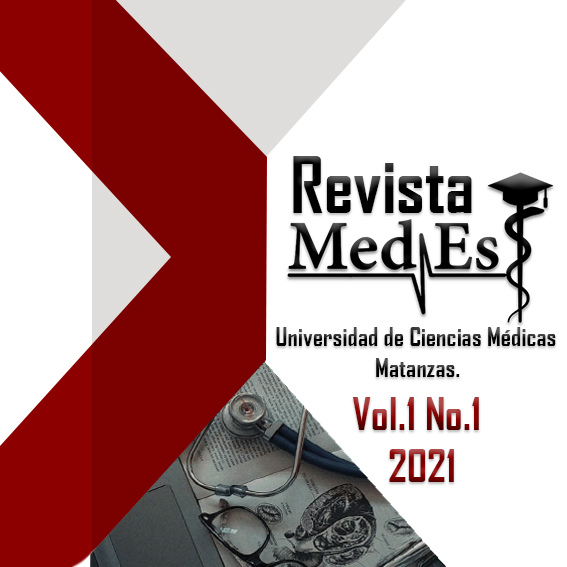COVID-19 and its relationships with stomatological action protocols
Keywords:
COVID-19, stomatological emergency, biosafetyAbstract
COVID-19 is the disease caused by a new coronavirus (SARS-CoV-2). The World Health Organization declared that the COVID-19 outbreak is a pandemic, essentially because of the speed in its spread, and because it is distributed on all continents, in which there are thousands of cases and numerous deaths. A bibliographic review was carried out in order to characterize the general aspects of the coronavirus and its relationship with the stomatological action protocols using databases such as Infomed, Pubmed and Scielo and selecting the information from the last five years. The presence of the virus in saliva, the short working distance between the stomatologist and the patient's mouth, together with the aerosols increase the risk of contamination when performing stomatological procedures. Stomatological personnel are among the most exposed to pathogens that remain in the oral cavity, including the new coronavirus (SARS-CoV-2).Downloads
References
2. Ji W, Wang W, Zhao X, Zai J, Li X. Cross-speciestransmission of thenewlyidentified coronavirus 2019-nCoV. J Med Virol [Internet]. 2020 [citado 7 de junio de 2020]; 92(4): 433-40. Disponible en: http://pubmed.ncbi.nlm.nih.gov/31967321/
3. Palacios Cruz M, Santos E, Velázquez Cervantes MA, León Juárez M. COVID-19, una emergencia de salud pública mundial. RevClín Esp. [Internet]. 2020 [citado 7 de junio de 2020]; 221(1):55-61. Disponible en: https://www.sciencedirect.com/science/article/pii/S0014256520300928
4. Callaway E, Cyranoski D. New China virus: Five questions scientists are asking. Nature [Internet]. 2020 [citado 2020 Jun 05]. Disponible en: https://www.nature.com/magazine-assets/d41586-020-00166-6/17601640
5. Colombia. Ministerio de Salud y Protección Social. Lineamiento para la atención de urgencias por alteraciones de la Salud Bucal, durante el período de la pandemia por SARS-COV-2 (COVID-19). [Internet]. 2020 [citado 7 de junio de 2020]. Disponible en: http://www.misgsst.com/public/documento/7mlH_J22Y4.pdf
6. MINSAP. Cuba frente a la COVID-19, día 89: Últimas noticias [Internet]. Cubadebate.cu. 2020 [Citado 7 de junio de 2020]. Disponible en: http://www.cubadebate.cu/noticias/2020/06/07/cuba-frente-a-la-COVID-19-dia-89-ultimas-noticias
7. MINSAP. Cuba reporta 1077 nuevos casos de COVID-19, la cifra más elevada desde inicios de la pandemia (+Video) [Internet]. Cubadebate.cu. 2021 [Citado 2 de abril de 2021]. Disponible en: http://www.cubadebate.cu/noticias/2021/04/02/cuba-reporta-1077-nuevos-casos-de-covid-19-la-cifra-mas-elevada-desde-inicios-de-la-pandemia-video/
8. Sepúlveda-Verdugo Cristóbal, Secchi-Álvarez Alfio, Donoso-Hofer Francisca. Consideraciones en la Atención Odontológica de Urgencia en Contexto de Coronavirus COVID-19 (SARS-CoV-2). Int. J. Odontostomat. [Internet]. 2020 [citado 2020 Jun 05] ; 14( 3 ): 279-284. Disponible en: https://scielo.conicyt.cl/scielo.php?script=sci_arttext&pid=S0718-381X2020000300279&lng=es. http://dx.doi.org/10.4067/S0718-381X2020000300279.
9. Sabino-Silva R, Gomes-Jardim AC, Siqueira WL. Coronavirus COVID-19 impactstodentistry and potentialsalivary diagnosis. Clinical Oral Investigations [Internet]. 2020 [citado 18 de junio de 2020]; 24: 1619–1621. Disponible en: https://doi.org/10.1007/s00784-020-03248-x.
10. Santos-Velázquez T, Panizo-Buzón SE, Díaz-Couso Y, Sánchez-Alonso N. Conocimientos de estomatólogos sobre prevención y control de la COVID-19. Rev. electron. Zoilo [Internet]. 2020 [citado 2020 Jun 18];45(3):[aprox. 0 p.]. Disponible en: http://www.revzoilomarinello.sld.cu/index.php/zmv/article/view/2292
11. MINSAP. Cuba frente a la COVID-19: detalles sobre las nuevas medidas adoptadas por el Gobierno cubano. [Internet]. Juventudrevelde.cu. 2020 [Citado 7 de junio de 2020]. Disponible en: http://www.juventudrebelde.cu/cuba/2020-03-24/cuba-frente-a-la-covid-19-2
12. American Dental Association. What Constitutes a Dental Emergency? [Internet]. Chicago: American Dental Association; 3/31/2020 [citado 7 de junio de 2020] Disponible en: https://success.ada.org/~/media/CPS/Files/Open%20Files/ADA_COVID19_Dental_Emergency_DDS.pdf
13. Peng X, Xu X, Li Y, Cheng L, Zhou X, Ren B. Transmissionrouts of 2019-nCov and controls in dental practice.Int. J. Oral Sci[Internet]. 2020 [citado 9 de junio de 2020]. Disponible en: https://doi.org/10.1038/s41368-020-0075-9
14. Meng L, Hua F, Bian Z. Enfermedad por coronavirus 2019 (COVID-19): desafíos emergentes y futuros para la medicina dental y oral. J. Dent. Res [Internet]. 2020 [citado 9 de junio de 2020]. Disponible en: http://doi.org/10.1177/0022034520914246
15. Watanabe A, Tamaki N,Yokota K, Matsuyama M, Kokeguchi S. Uso de bioluminiscencia ATP para estudiar la propagación de aerosoles y salpicaduras durante los tratamientos dentales. J HospInfect [Internet].2020 [citado 9 de junio de 2020]; 99(3):3035. Disponible en: http://doi.org/10.1016/j.jhin.2018.03.002
16. Consejo de Dentistas de España. Informe técnico del Consejo General de Dentistas de España. El nuevo Coronavirus 2019-nCOV y el manejo del paciente dental. Madrid: Consejo de Dentistas de España [Internet]. 2020 [citado 9 de junio de 2020] Disponible en: https://gacetadental.com/wp-content/uploads/2020/03/INFORME-TE%CC%81CNICO-DEL-CONSEJO-GENERAL.pdf
17. Araya-Salas Cristóbal. Consideraciones para la Atención de Urgencia Odontológica y Medidas Preventivas para COVID-19 (SARS-CoV 2). Int. J. Odontostomat. [Internet]. 2020 [citado 9 de junio de 2020]; 14(3):268-270. Disponible en: http://scielo.conicyt.cl/scielo.php?script=sci_arttext&pid=S0718-381X2020000300268&lng=es. http://dx.doi.org/10.4067/S0718-381X2020000300268.
18. Alharbi A, Alharbi S, Alqaidi S. Guidelinesfor dental careprovisionduringthe COVID-19 pandemic. SaudiDent. J. [Internet]. 2020 [citado 2020 Jun 09]; 32(4):181-6. Disponible en: https://doi.org/10.1016/j.sdentj.2020.04.001
19. Zhoun W. Consejos basados en la ciencia del manual de prevención de coronavirus que podrían salvar su vida 101. Wuhan China: Hubei Science and TechnologyPress; 2020 [Internet]. 2020 [citado 7 de junio de 2020]. Disponible en: https://invesp.org.ve/coronavirus-prevention-handbook-101-consejos-basados-en-la-ciencia-del-manual-de-prevencion-del-coronavirus-que-podrian-salvar-su-vida/
Published
How to Cite
Issue
Section
License
Those authors who have publications with this journal accept the following terms: The authors will retain their copyright and guarantee the journal the right of first publication of their work, which will be simultaneously subject to the Recognition License. Creative Commons that allows third parties to share the work as long as its author and its first publication in this magazine are indicated. Authors may adopt other non-exclusive license agreements for the distribution of the published version of the work (e.g.: deposit it in an institutional telematic archive or publish it in a monographic volume) as long as the initial publication in this journal is indicated. Authors are allowed and recommended to disseminate their work through the Internet (e.g.: in institutional telematic archives or on your website) before and during the submission process, which can produce interesting exchanges and increase citations of the published work.





